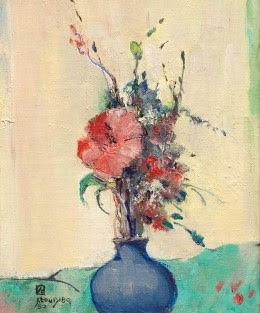What matter is that it is a wave.
What matters is that wave will return.
What matters is that it will always be different.
What matters the most of all: however different the returning wave,
It will always return as a wave of the sea.
What is a wave? Composition and muscle. The same goes for
lyrical poetry."
- Marina Tsvetayeva
By what alchemy do flat patches of color look like the waves of an incoming tide? A non-realistic painterly style characterized by flat patches of color is how, and that wave rolled in from France. I see the whitecaps as decorations on the blue/green breakers. Fairfield Porter's interest in decorative motifs was inspired by his admiration for the French artists known collectively as Les Nabis, in particular Pierre Bonnard. In his paintings Porter combined realism with flat abstraction; among his friends was fellow artist and abstract expressionist painter Willem de Kooning. Porter was a figurative painter in the post-war years when American abstract expressionism was triumphant. While at the Parsons School of Design, he studied with Jacques Maroger, a French art restorer.
During the Christmas holidays of 1938, Porter attended an exhibition at the Art Institute of Chicago of works by Bonnard and Edouard Vuillard. The exhibition came as a "revelation of the obvious" as Porter would recall to interviewer Paul Cummings in the 1960s. Why, he wondered, would he paint any other when way "it's so natural to do this." He also told Cummings, "I think that Ingres's remark that 'I leave it to time to finish my paintings' is true in a very wide and profound way."
Image: Fairfield Porter (1907-1975) - The Wave , 1971, oil on canvas, private collection




